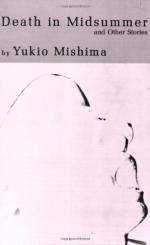|
This section contains 322 words (approx. 1 page at 400 words per page) |

|
Swaddling Clothes Summary & Study Guide Description
Swaddling Clothes Summary & Study Guide includes comprehensive information and analysis to help you understand the book. This study guide contains the following sections:
This detailed literature summary also contains Bibliography on Swaddling Clothes by Yukio Mishima.
Yukio Mishima's "Swaddling Clothes" was first published in Japan in 1955 in the highbrow literary journal Bungei. Its first English language publication appeared in Today's Japan, 1960, translated by Ivan Morris. The original Japanese title, "Shinbun-gami" simply means "newspapers" and the story's standard English title is an interpretive translation by Morris. It has since been included in several English translations of Mishima's work such as Death in Midsummer and Other Stories (1966). By 1955, Mishima was already a well-known literary figure, having received much attention and acclaim for his autobiographical Confessions of a Mask (1949) and Kinjiki [also known as Forbidden Colors (1951)]. During this early period, Mishima's works had not yet taken a decidedly political turn and were more interested in personal exploration and the nihilist aesthetics of the Roman-ha group (or "Japanese Romanticists") who took Mishima under their wing.
It would be difficult to exactly locate when Mishima's works became overtly political and whether or not Mishima even intended his early works to be characterized as such. But "Swaddling Clothes," published one year prior to The Temple of the Golden Pavilion, which is generally considered to criticize western importation of modernization and degraded moral values into Japan, and just ten years after Japan's devastating loss in World War II, can be read as political critique. "Swaddling Clothes" is a story replete with contrasts: tradition and modernization; sensitivity and callousness; morality and amorality; genuineness and artificiality; wealth and poverty. Through the author's omniscient narration of Toshiko's thoughts and the physical assault on Toshiko at the end of the story, Mishima offers a vision of modernization and change ushered in by western countries that is unwelcome and violent. The ambiguous ending (Is Toshiko raped? Does she die? Or, does she survive the attack and perhaps retaliate?) asks the reader to weigh the benefits and losses of change and modernization in a rapidly globalizing world and imagine what the fate of traditional values and ethics might be.
Read more from the Study Guide
|
This section contains 322 words (approx. 1 page at 400 words per page) |

|



